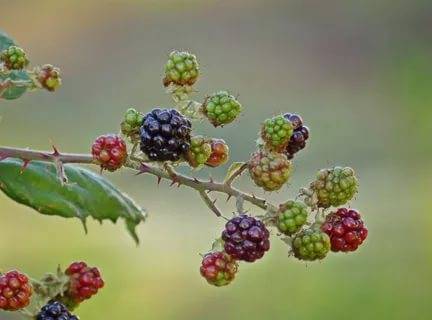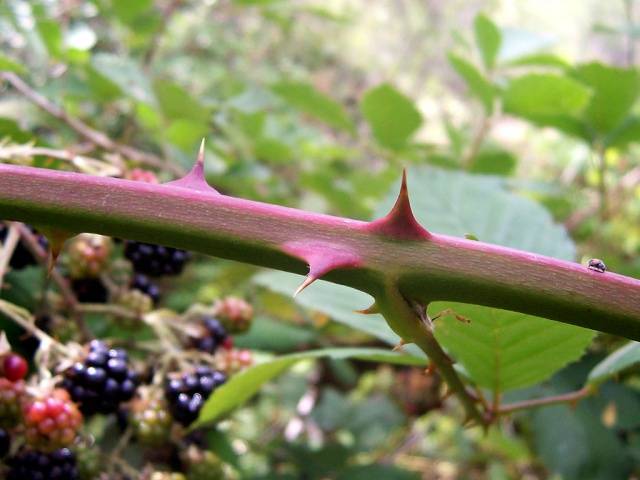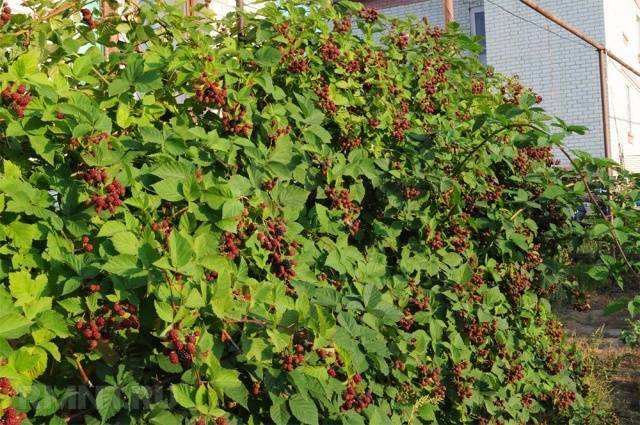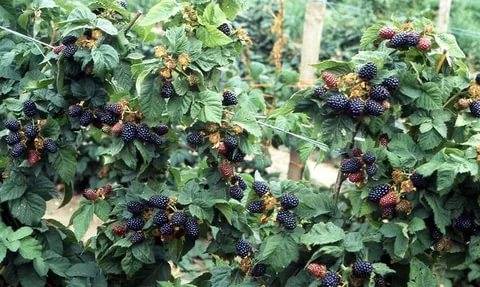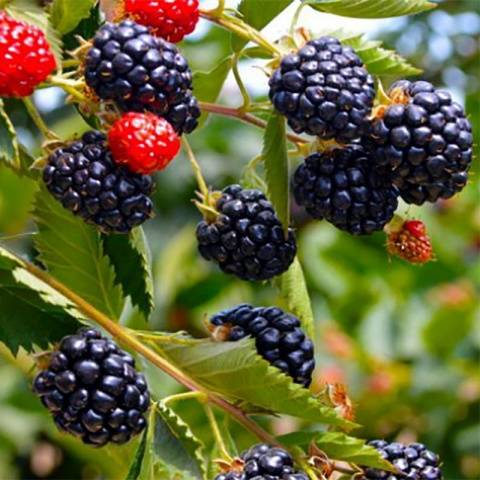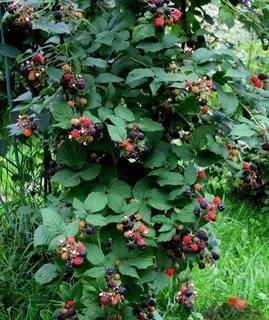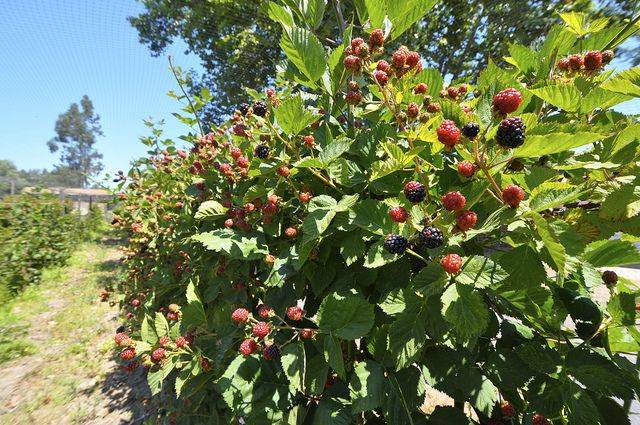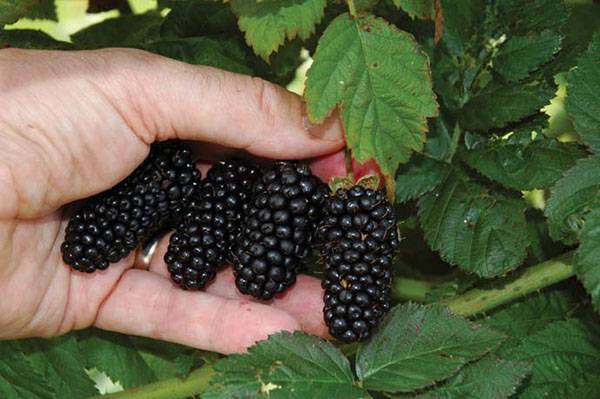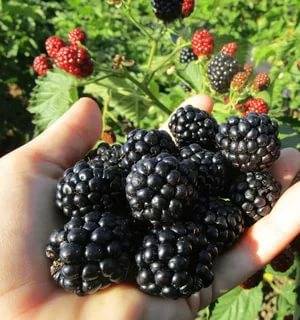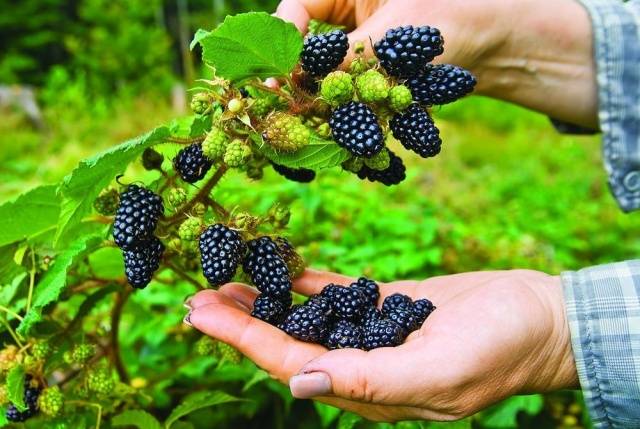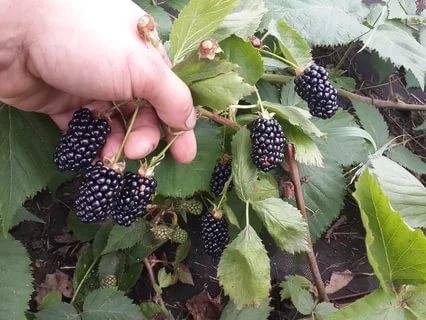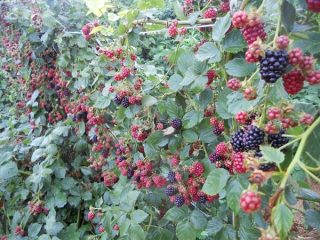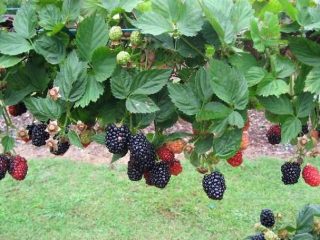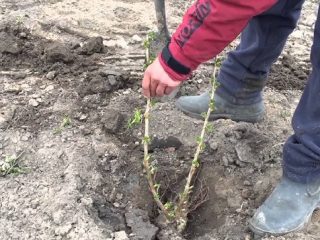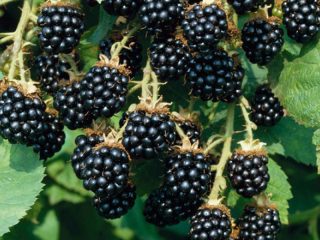Content
- 1 Classification of varieties
- 2 The most productive varieties of blackberries
- 3 The best varieties of remontant blackberries
- 4 Description of garden blackberry varieties
- 5 Classification of varieties by ripening time
- 6 Winter-hardy blackberry varieties
- 7 Bush blackberry varieties
- 8 creeping blackberry
- 9 How to choose the right variety
- 10 The best varieties of blackberries for the Moscow region
- 11 Suitable blackberry varieties for Siberia
- 12 The best blackberry varieties for central Russia
- 13 Blackberry varieties suitable for growing in southern Russia
- 14 Conclusion
- 15 Reviews
Wild blackberries are native to America. After reaching Europe, the crop began to get used to new climatic conditions and different types of soil. Breeders paid attention to the culture. When new varieties were developed, hybrids with improved characteristics appeared: large berries, absence of thorns, high yield. Now there are about 300 cultivated varieties, most of which belong to English selection.
Classification of varieties
Blackberries have many varieties.The culture is divided according to the structure of the bush into three main groups:
- Kumanika. The group includes erect plants, characterized by slightly bending stems.
- Rosyanika. All creeping plants fall under this definition. The length of sundew stems can reach 5 m or more.
- The semi-creeping culture group has few representatives. A special feature of the plant is the structure of its shoots. Initially, the branches grow erect, then gradually begin to creep.
Of all three groups, brambles are considered the most popular among gardeners.
According to the ripening period, the varieties are:
- early;
- average;
- late.
Of the three main groups based on ripening time, intermediate subcategories can be distinguished: mid-early and mid-late crops.
According to frost resistance, the plant is:
- sustainable;
- medium-resistant;
- unstable.
Hardy and moderately hardy species are suitable for growing in cold regions, but still require shelter for the winter. Blackberries that are not resistant to frost are best grown in the south.
According to the structure of the stem, plants are prickly and thornless. There is a specially bred remontant blackberry. The main difference between the crop is the fruiting on the branches of the current year. In autumn, the shoots are completely cut off at the root. Conventionally, blackberries are divided into groups according to large fruits, yield, and taste of the berries.
Initially, when developing new products, breeders focused on large fruits. At the same time, we achieved winter hardiness of the plant. The disadvantage of the berry plant is the thorns, which interfere with caring for the plant. Breeders decided to correct this problem. With the advent of thornless varieties, the culture immediately gained popularity. Experiments on the berry plant are constantly ongoing.Breeders are changing the timing of berry ripening and have achieved fruiting of the crop twice per season.
During the selection process, the characteristics of many varieties were intertwined. The division into groups is considered conditional. The same variety can be frost-resistant, early, large-fruited, or shade-tolerant. If a crop is not winter-hardy, this does not mean that it cannot be grown in the middle zone. The plant just needs special care, enhanced shelter for the winter.
The most productive varieties of blackberries
Gardeners primarily pay attention to yield. There is no such person who would not like to plant fewer bushes, but collect more berries. The list of productive varieties is presented in the table.
Name | Ripening time | Presence of thorns | Productivity | Disease resistance | Characteristic |
Agawam | Aug. Sept. | Prickly. | 10 kg per bush. | High. | The lashes of the bush grow more than 2 m long. The berry weight is 4 g. The plant can withstand frosts down to –30°C. |
Ufa local | August. | Prickly. | More than 10 kg per bush. | High. | Ufa local is a selected seedling of the Agavam variety. Superior in frost resistance and fruit sugar content. Berry weight 3 g. |
Flint | Mid-July. | Prickly. | Up to 10 kg per bush. | High. | The bushes grow up to 3 m in height and can withstand frosts of –40°C. Berry weight 7 g. |
The best varieties of remontant blackberries
Remontant culture is prickly and thornless. The plant with thorns is usually of medium height, but the fruiting rate is high. To get an early large harvest, thinning pruning of the bush is done. Up to five powerful branches are left on the plant. Europeans grow remontant blackberries indoors, thereby prolonging the fruiting period.
Name | Ripening time | Presence of thorns | Productivity | Disease resistance | Characteristic |
Reuben | August – October. | Blackberries are prickly, but there are no thorns on the fruiting branches. | Initially low, but constantly increasing every year. | High. | The length of the lashes is about 2 m. The weight of the berries is 14.5 g. The bush is erect, tolerates drought, and poor soil. Winter hardiness is high. |
Black Magic | Second ten days of August. If you leave second-year branches, they will give birth in July. | The main branches are thorny. There are no thorns near the berries. | More than 6 kg per bush. | High. | Berry weight is 11 g. The plant is frost-resistant, bears fruit well in drought. The bush is erect, 2 m high. |
Prime Ark 45 | End of August – beginning of September. | Thorns only on the lower shoots. | The variety passed the high yield test in 2009. | High. | Winter hardiness is weak. Berry weight is 9 g. For the winter, the roots require good shelter. |
Prime Jan | End of August – beginning of September. | Thorns on the main branches. | Productivity is medium-high. | High. | The bush is erect. The length of the lashes is about 2 m. The size and weight of the berries is average. The plant takes root in poor conditions. |
Prime Jim | Unknown. | Barbed. | Unknown. | Unknown. | The new variety is being tested. What is known about the culture is that the taste of the berries is reminiscent of mulberries. Erect bush of medium height. It is recommended to cut off the branches for the winter. |
Description of garden blackberry varieties
All cultivated varieties are suitable for garden blackberries, the descriptions of which are presented in the tables. Separately, I would like to consider the Marion hybrid.The raspberry-blackberry crop is taken as a standard by breeders developing new berry trees. The bushes are tall. The length of the thorny lashes reaches 6 m. The ripening period is early. The first berries ripen at the end of June. Fruit weight is more than 5 g. The berries are aromatic and tasty. Productivity is high.
Classification of varieties by ripening time
To grow a good harvest, you need to choose the right berry plant according to the ripening period. In the south, even the late culture will have time to mature. For northern regions, it is better to prefer early or mid-early varieties.
Early varieties of blackberries
This group includes all blackberries, the berries of which begin to ripen by the end of June. The fruits of early cultivation are usually sour and weakly saturated with aroma. Blackberries are more suitable for processing into jam.
Name | Ripening time | Presence of thorns | Productivity | Disease resistance | Characteristic |
Medana Tayberry | June – early July. | Prickly. | Productivity is high. The variety is suitable for commercial use. | High. | The raspberry-blackberry hybrid requires shelter for the winter. Spreading bush with long vines. |
Black Butte | Mid June. | Small spines. | The new variety is considered high-yielding. | High. | Creeping bush that tolerates drought well. Fruiting lasts 1.5 months. Berry weight is from 12 to 23 g. |
Giant (Bedford Giant) | Early July. | Prickly. | The variety is high-yielding. | High. | Creeping bush. Winter hardiness is high. Berry weight is about 7 g. |
El Dorado | The ripening of the crop is early, but very extended. | Big spikes. | High-yielding variety. | High. | Winter hardiness is average. Shelter is required for the winter. An erect bush with long shoots. |
Mid-season
Mid-ripening berries begin to bear fruit when the fruits of early blackberries begin to fade.A feature of the culture is the uniform ripening of the crop. The berries are sweet, aromatic, and produce rich juice.
Name | Ripening time | Presence of thorns | Productivity | Disease resistance | Characteristic |
Tupi (“Tupi”). | July August. | Small spines. | High yield. The berries are sold to supermarkets. | High. | The Brazilian variety is moderately resistant to frost and requires shelter. The bush is erect. Berry weight 10 g. |
Lawton | July August. | Large brown thorns. | About 10 kg per plant. | High. | An erect bush with branches up to 2.6 m long. Berry weight is 4 g. Winter hardiness is average. Withstands frost down to – 21°C. |
Late blackberry varieties
In order for the berries to ripen, it is better to grow late berry plants in the south. Harvest occurs in August – September. Blackberries are great for canning, producing a tasty, flavorful juice.
Name | Ripening time | Presence of thorns | Productivity | Disease resistance | Characteristic |
Texas | August. | Large spines. | Average. | Normal. | Michurinsky gift brings berries weighing 11 g. Creeping bush without root shoots. |
Chokeberry | Aug. Sept. | Lots of small thorns. | Up to 5 kg per bush. | Normal. | The culture of folk selection produces 17 medium-sized berries on one branch. The length of fruiting vines is 1.6 m. |
Abundant | August. | Small spines. | Average. | Normal. | The length of the shoots reaches 3.5 m. The weight of the berries is 4 g. Winter hardiness is weak. |
Winter-hardy blackberry varieties
Winter-hardy berry plants are more suitable for residents of cold regions. Most of these crops are thornless and are hybrids. Among the prickly varieties, Agawam is the leader in winter hardiness. The Bedford Giant copes well with frost.
Gazda
A vigorous bush with small thorns begins to bear fruit in the second year. Harvest ripening occurs in August – September. After harvesting the berries, the fruiting shoots are cut out. The bush is resistant to diseases. The berries are large, weighing up to 7 g. The fruits can be stored and transported. Blackberries prefer fertile loamy soil and sunny areas.
Darrow
The erect bush grows up to 3 m high. The sweet and sour fruits weigh about 4 g. The yield increases with each year of cultivation. On average, up to 10 kg of berries are harvested from a bush. In terms of winter hardiness, Darrow is second only to Agave blackberries. The plant can withstand frosts down to –34OWITH.
Bush blackberry varieties
Growing bush blackberries is much easier due to the compactness of the plant. The lashes need to be tied up in the same way, but their growth is limited. Among the bush berry plants one can distinguish Agavam, Lawton, Chokeberry. Descriptions of these crops are presented in tables.
creeping blackberry
Creeping berry plants grow long shoots. The lashes are able to weave along the ground, but the berries will rot and harvesting will be difficult. Creeping blackberries include: Texas, Black Butte, and Bedford Giant. Descriptions of crops are presented in tables.
Separately, it is worth considering the creeping berry plant Karaka Black. Prickly blackberries bear large berries weighing 11 g. The yield is average, no more than 5 kg per bush. Fruit ripening is early. Bushes are planted in the garden bed, keeping a distance of at least 1 m. Fruiting lasts up to 8 weeks. The berry can be stored and is suitable for sale.
How to choose the right variety
In order for the selected blackberry variety to fully justify its characteristics, the plant is selected taking into account the climate of the region. In the south you can grow almost any crop. In the middle zone the situation is similar, only even winter-hardy bushes will have to be covered in the fall. For northern regions, it is better to choose frost-resistant berries of early and mid-ripening period. Late blackberries in a short summer will not have time to bear all the fruits.
All blackberries are famous for their drought resistance. The roots of the plant are quite long and go deep into the ground. The plant obtains its own moisture. However, without watering, the quality of the berries deteriorates.
Productivity is a powerful argument when choosing blackberries. It is worth considering that at home the figure will be slightly lower than that declared by the manufacturer. This is due to the fact that most gardeners are bound to make agricultural mistakes.
If you focus on taste, then it is better to give preference to middle and late crops. You can plant 1-2 bushes of early blackberries. The berries of this crop are less sweet and aromatic. The taste of the fruit also depends on climatic conditions. In colder regions, the same variety of blackberry will be much more sour than in the south.
The best varieties of blackberries for the Moscow region
The climate of the Moscow region allows you to grow all varieties of blackberries, but for the winter you need to organize a reliable shelter. The culture is afraid not so much of frost as of snowless winters.
Early blackberry varieties for the Moscow region
From early spiny representatives you can grow a Giant (Bedford Giant). Blackberries are frost-resistant, but for successful wintering they need to be covered. The drought-tolerant berries of Black Butte and Eldorado will take root well.
Unpretentious and productive blackberry varieties for the Moscow region
In terms of unpretentiousness, Agavam is the leader. Breeders among themselves call the crop a weed. Blackberries quickly adapt to local conditions. The bushes will bear fruit in one place for up to 10 years. The next most unpretentious is Darrow.
The best varieties of remontant blackberries for the Moscow region and the Moscow region
Remontant varieties are excellent for the climate of these areas, as they tolerate cold and little snow winters. Blackberries are not afraid of a long autumn or a long spring with cold nights. Remontant berry gardens are ideal for areas where there are a lot of rodents: mice, voles, hares. In these areas you can grow Black Magic, Ruben, Prime Arc 45, Prime Yang.
Suitable blackberry varieties for Siberia
In the Siberian climate, it is better to grow winter-hardy blackberries that bear fruit in June – July or early August.
Frost-resistant blackberry varieties for Siberia
Of the varieties resistant to severe frosts, you can give preference to Darrow and Gazda. Plants can withstand temperatures below –30OC. Berries can be harvested mechanically. The bushes are planted in a sunny area, protected from northern winds. Agave will take root well in Siberia.
Suitable early ripening blackberry varieties for Siberia
Of the early varieties, Eldorado blackberries adapt well to the Siberian climate. To prevent the plant from freezing, in winter the bushes are covered generously with snow.
The best blackberry varieties for central Russia
Climatic conditions are excellent for all remontant varieties. In autumn, the above-ground part is completely cut off, which protects the bushes from freezing or being eaten by rodents. The roots remaining in the ground are well insulated with mulch and shelter from Christmas tree or pine branches.
The highest yielding blackberry varieties for the middle zone
Agave blackberries will bring good harvests in areas with unstable climates. The Ufimskaya local and Flint varieties are not inferior in frost resistance and yield.
Blackberry varieties suitable for growing in southern Russia
In the southern regions, you can grow any crop without shelter, even if the plant can withstand only -17OFrom the frost. Specifically, among the thorny blackberries, Loughton is considered a southerner.
The video shows an overview of the fruiting of different varieties of blackberries:
Conclusion
If you decide to plant blackberries on your plot, it is better to buy seedlings at a nursery. This is the only way to guarantee that you will get exactly the variety you dreamed of.
